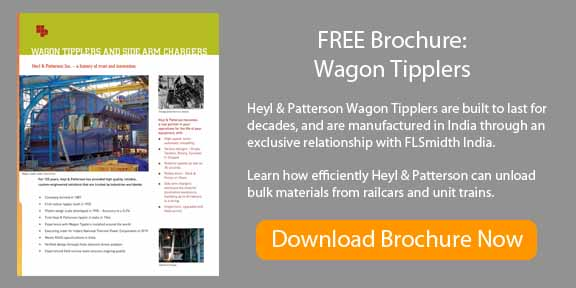 Heyl & Patterson manufactures Rota-Side Wagon Tipplers and side arm chargers for the Indian market through an exclusive relationship with FLSmidth India. While some tippler manufacturers are capable of offering either Turnover Wagon Tipplers or C-Frame Rotary Tipplers, Heyl & Patterson offers both models. Either style can be installed at a customer's site, depending on the site conditions, and both tippler designs comply with the latest RDSO specifications, G33 Rev 1.
Heyl & Patterson manufactures Rota-Side Wagon Tipplers and side arm chargers for the Indian market through an exclusive relationship with FLSmidth India. While some tippler manufacturers are capable of offering either Turnover Wagon Tipplers or C-Frame Rotary Tipplers, Heyl & Patterson offers both models. Either style can be installed at a customer's site, depending on the site conditions, and both tippler designs comply with the latest RDSO specifications, G33 Rev 1.
Rotaside tipplers lift a wagon during operation, reducing the depth of the reciving hopper and foundation. On the C-Frame Rotary, the crescent design allows the side arm charger to ride through the tippler barrel. Both single and tandem designs can be offered, and their drive arrangement can be either electromechanical or hydraulic. All designs are verified through finite element stress analysis, and each supply is backed by an experienced service team, ensuring field service for the life of the equipment.
The Wagon Tippler has eight main components:
- Platen Assembly
- End Rings
- Clamp Assembly
- Counterweight
- Spill Truss
- Wheel Grippers
- Wheel Chocks
- Drive Unit
The platen assembly is a fabricated steel structural frame, which consists of an inner platen and an outer platen. The inner platen is placed on top of the outer one, and the weigh bridge cells are mounted between the two. Standard broad gauge rails are mounted on the inner platen frame. The entire platen is designed so that an Indian locomotive engine of 150 tons in weight can pass over it at a maximum speed of 8 kph (5 mph). Eight load cells of adequate capacity are provided in between the inner and outer platen. These load cells are used for measuring the tare and gross weight of the wagons, in the range of =/- 0.2% capacity.
The end rings are fabricated steel frames of semi-circular shape. Two end rings are connected by the spill girder, top clamp beam and counterweight box girder. The end rings support the platen assembly, along with the loaded wagon to be tipped. Each end ring is supported on a trunnion shaft mounted on plummer blocks, which are supported on a steel stool or pedestal.
The wagon tippler is equipped with six hydraulically-operated steel clamping arms moving through the hydraulic cylinder. All the clamps are designed to more into position as the wagon tippler begins to rotate, and they clamp on the top of the wagon at a pre-determined angle and hold the wagon firmly until it returns to its normal resting position, when the clamps release the wagon. The clamping system is designed so that it can clamp both the maximum and the minimum height of the wagon being tipped. The clamping system is capable of holding a fully loaded wagon at any position during the operation.
Each cylinder is provided with a spring assembly mounted opposite the piston rod end, and fastened to the end ring structure to permit the pivot beam to move upward when the material is discharged from the wagon. This movement is to compensate for the release of the compressed spring of the wagon bogie when the material is discharged from the loaded wagon.
The counterweight is located in a separate counterweight box fitted to the end rings, with a simple design leads to faster erection time.
The side supporting beam, also known as the spill truss or spill girder, is of welded steel construction. It connects the two end rings and supports the loaded wagon lengthwise during operation. The side wall moves through hydraulic cylinders and touches the wagon standing on the platen without applying pressure.
Two sets of hydraulically operated wheel grippers on the rails are fitted to the platform to grip the wagon wheels and prevent any derailing during the tippling operation.
Hydraulically operated wheel chocks on the inhaul and outhaul side of the platen prevent the wagon wheels from rolling back on the platen.
The drive unit is either electromechanical or hydraulic. A electromechanical drive consists of an electric motor coupled with a speed reduction gear box and brake mounted on the input shaft of the gear box. A hydraulic drive consists of a power pack with electric motor and a hydraulic motor coupled with a helical gear box. The brake is built into the hydraulic motor, and an external hydraulic thruster brake is mounted on the input shaft of the gear box.
For over 125 years, Heyl & Patterson has provided high quality, reliable, custom-engineered solutions that are trusted by industries worldwide. The company built is first railcar tippler is 1939, and its first wagon tippler in India was installed in 1964. In 2010, Heyl & Patterson received certification by India’s National Thermal Power Corporation (NTPC) to manufacture industrial capital equipment in India, essentially becoming the NTPC's preferred supplier.
To learn more about Heyl & Patterson wagon tipplers, click here:






